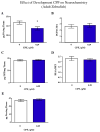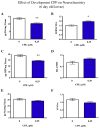Zebrafish provide a sensitive model of persisting neurobehavioral effects of developmental chlorpyrifos exposure: comparison with nicotine and pilocarpine effects and relationship to dopamine deficits
- PMID: 19268529
- PMCID: PMC2885770
- DOI: 10.1016/j.ntt.2009.02.005
Zebrafish provide a sensitive model of persisting neurobehavioral effects of developmental chlorpyrifos exposure: comparison with nicotine and pilocarpine effects and relationship to dopamine deficits
Abstract
Chlorpyrifos (CPF) an organophosphate pesticide causes persisting behavioral dysfunction in rat models when exposure is during early development. In earlier work zebrafish were used as a complementary model to study mechanisms of CPF-induced neurotoxicity induced during early development. We found that developmental (first five days after fertilization) chlorpyrifos exposure significantly impaired learning in zebrafish. However, this testing was time and labor intensive. In the current study we tested the hypothesis that persisting effects of developmental chlorpyrifos could be detected with a brief automated assessment of startle response and that this behavioral index could be used to help determine the neurobehavioral mechanisms for persisting CPF effects. The swimming activity of adult zebrafish was assessed by a computerized video-tracking device after a sudden tap to the test arena. Ten consecutive trials (1/min) were run to determine startle response and its habituation. Additionally, habituation recovery trials were run at 8, 32 and 128 min after the end of the initial trial set. CPF-exposed fish showed a significantly (p<0.025) greater overall startle response during the 10-trial session compared to controls (group sizes: Control N=40, CPF N=24). During the initial recovery period (8 min) CPF-exposed fish showed a significantly (p<0.01) greater startle response compared to controls. To elucidate the contributions of nicotinic and muscarinic acetylcholine receptors to developmental CPF-mediated effects, the effects of developmental nicotine and pilocarpine exposure throughout the first five days after fertilization were determined. Developmental nicotine and pilocarpine exposure significantly increased startle response, though nicotine (group sizes: Control N=32, 15 mM N=12, 25 mM N=20) was much more potent than pilocarpine (group sizes: Control N=20, 100 microM N=16, 1000 microM N=12). Neither was as potent as CPF for developmental exposure increasing startle response in adulthood. Lastly, developmental CPF exposure decreased dopamine and serotonin levels and increased transmitter turnover in developing zebrafish larvae (N=4 batches of 50 embryos/treatment). Only the decline in dopamine concentrations persisted into adulthood (group sizes: Control N=14, CPF N=13). This study shows that a quick automated test of startle can detect persisting neurobehavioral impairments caused by developmental exposure to CPF. This may be helpful in screening for persisting neurobehavioral defects from a variety of toxicants.
Copyright 2009. Published by Elsevier Inc.
Conflict of interest statement
Nothing declared.
Figures






Similar articles
-
Critical duration of exposure for developmental chlorpyrifos-induced neurobehavioral toxicity.Neurotoxicol Teratol. 2011 Nov-Dec;33(6):742-51. doi: 10.1016/j.ntt.2011.06.005. Epub 2011 Jul 2. Neurotoxicol Teratol. 2011. PMID: 21745564 Free PMC article.
-
Developmental chlorpyrifos effects on hatchling zebrafish swimming behavior.Neurotoxicol Teratol. 2004 Nov-Dec;26(6):719-23. doi: 10.1016/j.ntt.2004.06.013. Neurotoxicol Teratol. 2004. PMID: 15451035
-
Neurobehavioral impairments caused by developmental imidacloprid exposure in zebrafish.Neurotoxicol Teratol. 2015 May-Jun;49:81-90. doi: 10.1016/j.ntt.2015.04.006. Epub 2015 May 2. Neurotoxicol Teratol. 2015. PMID: 25944383 Free PMC article.
-
Chlorpyrifos exposure of developing zebrafish: effects on survival and long-term effects on response latency and spatial discrimination.Neurotoxicol Teratol. 2003 Jan-Feb;25(1):51-7. doi: 10.1016/s0892-0362(02)00322-7. Neurotoxicol Teratol. 2003. PMID: 12633736
-
Effects of low-dose chlorpyrifos on neurobehavior and potential mechanisms: A review of studies in rodents, zebrafish, and Caenorhabditis elegans.Birth Defects Res. 2020 Apr 1;112(6):445-479. doi: 10.1002/bdr2.1661. Epub 2020 Mar 1. Birth Defects Res. 2020. PMID: 32115908 Review.
Cited by
-
Using sets of behavioral biomarkers to assess short-term effects of pesticide: a study case with endosulfan on frog tadpoles.Ecotoxicology. 2012 May;21(4):1240-50. doi: 10.1007/s10646-012-0878-3. Epub 2012 Mar 1. Ecotoxicology. 2012. PMID: 22383141
-
Toxicity of 3,5,6-trichloro-2-pyridinol tested at multiple stages of zebrafish (Danio rerio) development.Environ Sci Pollut Res Int. 2016 Aug;23(15):15515-23. doi: 10.1007/s11356-016-6684-3. Epub 2016 Apr 28. Environ Sci Pollut Res Int. 2016. PMID: 27121015
-
Adult exposure to insecticides causes persistent behavioral and neurochemical alterations in zebrafish.Neurotoxicol Teratol. 2020 Mar-Apr;78:106853. doi: 10.1016/j.ntt.2019.106853. Epub 2020 Jan 3. Neurotoxicol Teratol. 2020. PMID: 31911208 Free PMC article.
-
Delayed effects of developmental exposure to low levels of the aryl hydrocarbon receptor agonist 3,3',4,4',5-pentachlorobiphenyl (PCB126) on adult zebrafish behavior.Neurotoxicology. 2016 Jan;52:134-43. doi: 10.1016/j.neuro.2015.11.012. Epub 2015 Nov 23. Neurotoxicology. 2016. PMID: 26616910 Free PMC article.
-
Zebrafish model systems for developmental neurobehavioral toxicology.Birth Defects Res C Embryo Today. 2013 Mar;99(1):14-23. doi: 10.1002/bdrc.21027. Birth Defects Res C Embryo Today. 2013. PMID: 23723169 Free PMC article. Review.
References
-
- Aldridge JE, Seidler FJ, Slotkin TA. Developmental exposure to chlorpyrifos elicits sex-selective alterations of serotonergic synaptic function in adulthood: critical periods and regional selectivity for effects on the serotonin transporter, receptor subtypes, and cell signaling. Environmental Health Perspectives. 2004;112:148–155. - PMC - PubMed
-
- Arthur D, Levin ED. Spatial and non-spatial discrimination learning in zebrafish (Danio rerio) Animal Cognition. 2001;4:125–131.
Publication types
MeSH terms
Substances
Grants and funding
LinkOut - more resources
Full Text Sources
Miscellaneous

